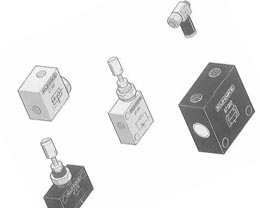Types of Pneumatic Flow Control Valves
The primary function of a flow control valve is to regulate the pressure of a flow of fluid in a pneumatic system. Different types of flow control valves are available because each has a slightly different function. The variations between devices allow for pneumatic systems to work properly. Two separate pneumatic systems might require different functionality from a flow control valve. Knowing the difference between types will help your pneumatic system run smoothly. Common types of flow control valves include:

Needle Control Valves: This type of monitoring valve is considered a variable control valve that does not have pressure compensated. Fluid will be forced to make two 90 degrees turns. A needle is in the valve and in the way of liquids. The needle creates pressure differentials that break up upstream and downstream. Pulling the needle in and out allows users to control the flow rate.
Ball Valve: This design has a pivoting ball that aims to control flow. The valve will open when the hole of the ball is lined up with the flow. It will close when the ball is pivoted (as a result of the valve handle). These pneumatic valves are durable and reliable throughout many cycles.
Butterfly Valve: These valves are specially designed to do one of two things: isolate and regulate flow. This system requires pressure drops to induce flow (regardless of the position of the valve).
Pneumatic Valves
The above list of types does not cover all the different versions of flow control valves. For more information about different styles and how they function within a pneumatic system, please reach out to us for more details.
Related Reading about Pneumatic Valves
- The Basics of Pneumatic Valves
Purchasing pneumatic valves can seem like a daunting task for business owners. There are so many options to choose.
- Pneumatic Valve Configurations
- Valve Directional-Control
- Flow Control Valves
- Pneumatic Systems and Safety
- Advantages of Pneumatic Systems


- Ellis/Kuhnke Controls
132 Lewis Street Unit A-2, Eatontown, N.J. 07724
Phone: 1-800-221-0714
Fax: 732-291-8154
Email: Info@ekci.com
- Home Pneumatic Controls Technical Info CAD Drawings Contact Us Pneumatic Timers Blog Site Map
